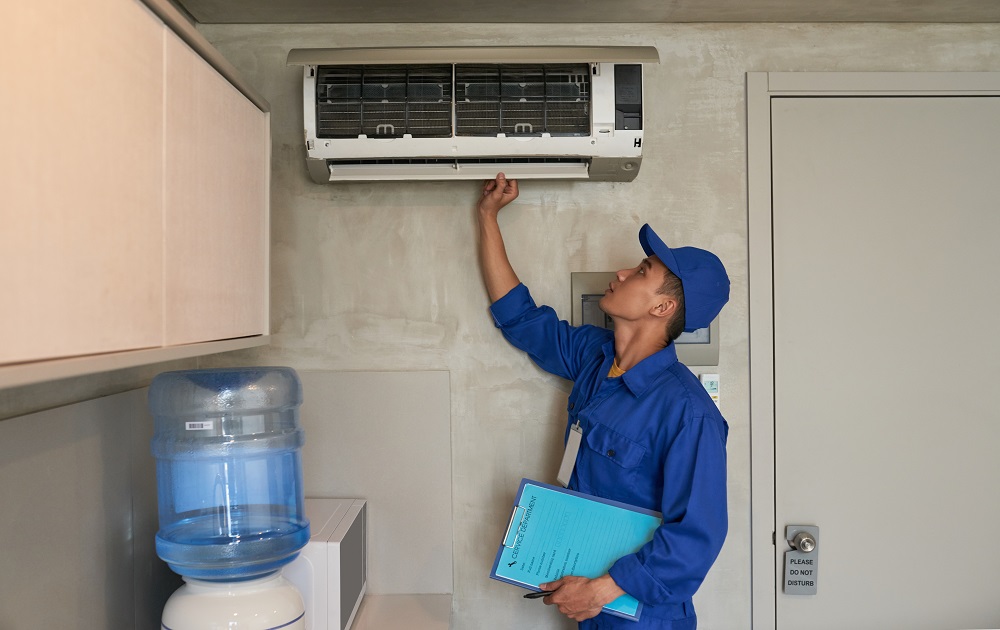In Pakistan’s growing residential and commercial sectors, choosing the right air conditioning system is no longer just about cooling — it’s about efficiency, cost savings, sustainability, and smart technology. With soaring temperatures in cities like Karachi, Lahore, and Islamabad, air conditioning is essential. But what’s the better investment: Traditional Split ACs or Variable Refrigerant Flow (VRF) systems?
At Smart Climate Solutions Pvt Ltd, we’ve helped hundreds of homes and businesses across Pakistan transition to more efficient, reliable cooling systems. In this guide, we’ll compare both systems and highlight 7 undeniable advantages of VRF systems over split ACs.

What Is a VRF System?
Variable Refrigerant Flow (VRF) is a modern HVAC technology that uses refrigerant as the cooling and heating medium. It allows one outdoor unit to connect with multiple indoor units, automatically adjusting the refrigerant flow to meet each room’s specific cooling or heating demand.
It’s ideal for large homes, commercial buildings, office spaces, and modern apartments.
Top 7 Advantages of VRF Systems Over Traditional Split ACs
1. Superior Energy Efficiency
VRF systems are designed to consume energy only when and where it’s needed. Unlike split ACs, which run at a constant speed, VRF systems adjust compressor speed based on the cooling load. This reduces electricity usage by up to 30–40%, a major advantage in cities like Lahore and Karachi where power bills can spike in summer.
✅ Real Impact: Businesses switching to VRF systems have reported monthly savings of up to Rs. 25,000 in electricity bills.
2. Zoning and Individual Control
In a typical Pakistani home or office, not all rooms require the same temperature. VRF systems allow individual temperature control for each indoor unit. So, you can keep your bedroom cool while setting the lounge at a warmer temperature — ideal for joint family systems or offices with multiple departments.
🧠 Smart zoning makes VRF perfect for multi-storey homes, clinics, banks, and educational institutions in Pakistan.
3. Minimal Installation Footprint
Traditional split systems require one outdoor unit for every indoor unit, which can clutter walls or balconies. VRF systems connect multiple indoor units to a single outdoor unit, reducing the space needed and keeping the building façade cleaner.
🏢 Perfect for high-rise buildings and commercial plazas where space is limited.
4. Quiet Operation
With compressors and major components located outside and advanced indoor unit technology, VRF systems operate much more quietly than traditional split systems. This is a major benefit in hospitals, schools, libraries, and luxury homes where silence is critical.
🔇 Say goodbye to the humming noise of split ACs during meetings or sleep.
5. Longer Lifespan and Low Maintenance
VRF systems are built for durability and long-term use. Since they operate more efficiently and undergo less wear and tear, they last longer than conventional split ACs. Additionally, fewer outdoor units and smart diagnostics mean lower maintenance costs over the years.
🛠️ A well-installed VRF system can last 15–20 years with routine checkups.
6. Flexible Design for Complex Spaces
VRF systems are ideal for complex building layouts like multi-floor homes, malls, restaurants, or mosques. The indoor units come in various types (ceiling cassette, wall-mounted, ducted) and can be installed up to 1000 feet away from the outdoor unit, giving architects and builders maximum flexibility.
🏗️ No need to redesign your building to fit AC units — VRF adapts to your structure.
7. Eco-Friendly Technology
In Pakistan, where energy consumption and climate change are growing concerns, VRF systems use environmentally friendly refrigerants like R-410A or R-32. They also reduce energy waste, contributing to sustainable, green construction goals.
🌱 Ideal for LEED-certified buildings or developers promoting eco-conscious living.
When to Choose a VRF System Over Split AC
| Situation | Recommended System |
| Small rooms or apartments | Split AC |
| Multi-room homes | VRF System |
| Commercial offices | VRF System |
| Clinics, hospitals, schools | VRF System |
| Budget under Rs. 200,000 | Split AC |
| Budget above Rs. 500,000 | VRF System (long-term ROI) |
Why Smart Climate Solutions Pvt Ltd Recommends VRF
As Pakistan’s climate gets harsher and electricity rates increase, Smart Climate Solutions Pvt Ltd is committed to offering future-ready cooling technologies. We recommend VRF systems to clients who want comfort, savings, and sustainability, especially for commercial or multi-room projects.
While traditional split ACs are still a good choice for single-room usage, VRF systems offer unmatched advantages for homes and businesses that want high-performance, energy-efficient, and modern air conditioning solutions. As energy costs rise across Pakistan, investing in VRF can lead to significant long-term savings and comfort.
Whether you’re building a new home or upgrading your office cooling, Smart Climate Solutions Pvt Ltd can help you design and install the ideal VRF system tailored to your needs.
5 Frequently Asked Questions (FAQs)
1. Is a VRF system suitable for Pakistani weather conditions?
Yes, VRF systems are built to handle extreme temperatures and humidity, making them ideal for Pakistan’s climate, especially in cities like Lahore, Multan, and Karachi.
2. Are VRF systems more expensive than split ACs?
Initially, yes. VRF systems have a higher upfront cost but offer long-term savings in electricity bills and maintenance.
3. Can I install a VRF system in an existing building?
Absolutely. VRF systems are flexible and can be retrofitted in existing homes or offices with minimal disruption.
4. How much can I save on electricity bills with a VRF system?
On average, users in Pakistan save 30–40% on energy costs, depending on system size and usage patterns.
5. Does Smart Climate Solutions Pvt Ltd offer after-sales service for VRF systems?
Yes! We provide full maintenance, repair, and AMC (Annual Maintenance Contracts) for VRF systems across Pakistan.
